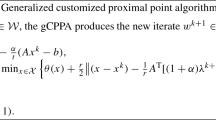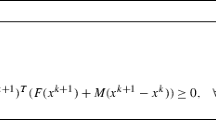Abstract
The proximal point algorithm (PPA) is a fundamental method for convex programming. When applying the PPA to solve linearly constrained convex problems, we may prefer to choose an appropriate metric matrix to define the proximal regularization, so that the computational burden of the resulted PPA can be reduced, and sometimes even admit closed form or efficient solutions. This idea results in the so-called customized PPA (also known as preconditioned PPA), and it covers the linearized ALM, the primal-dual hybrid gradient algorithm, ADMM as special cases. Since each customized PPA owes special structures and has popular applications, it is interesting to ask wether we can design a simple relaxation strategy for these algorithms. In this paper we treat these customized PPA algorithms uniformly by a mixed variational inequality approach, and propose a new relaxation strategy for these customized PPA algorithms. Our idea is based on correcting the dual variables individually and does not rely on relaxing the primal variables. This is very different from previous works. From variational inequality perspective, we prove the global convergence and establish a worst-case convergence rate for these relaxed PPA algorithms. Finally, we demonstrate the performance improvements by some numerical results.



Similar content being viewed by others
References
Beck, A., Teboulle, M.: A fast iterative shrinkage-thresholding algorithm for linear inverse problems. SIAM J. Imaging Sci. 2, 183–202 (2009)
Boyd, S., Parikh, N., Chu, E., Peleato, B., Eckstein, J.: Distributed optimization and statistical learning via the alternating direction method of multipliers. Found. Trends Mach. Learn. 3, 1–122 (2010)
Cai, J.F., Candès, E.J., Shen, Z.W.: A singular value thresholding algorithm for matrix completion. SIAM J. Optim. 20, 1956–1982 (2010)
Cai, X.J., Gu, G.Y., He, B.S., Yuan, X.M.: A proximal point algorithm revisit on the alternating direction method of multipliers. Sci. China Math. 56, 2179–2186 (2013)
Chambolle, A., Pock, T.: Diagonal preconditioning for first order primal-dual algorithms in convex optimization. In: IEEE International Conference on Computer Vision (ICCV), pp. 1762–1769 (2011)
Chambolle, A., Pock, T.: A first-order primal-dual algorithm for convex problems with applications to imaging. J. Math. Imaging Vis. 40, 120–145 (2011)
Chambolle, A., Pock, T.: On the ergodic convergence rates of a first-order primal-dual algorithm. Math. Program. 159, 253–287 (2016)
Chambolle, A., Pock, T.: An introduction to continuous optimization for imaging. Acta Numer. 25, 161–319 (2016)
Chan, T.F., Glowinski, R.: Finite Element Approximation and Iterative Solution of a Class of Mildly Nonlinear Elliptic Equations, Technical Report STAN-CS-78-674. Stanford University, Computer Science Department (1978)
Daubechies, I., Defrise, M., Mol, C.D.: An iterative thresholding algorithm for linear inverse problems with a sparsity constraint. Commun. Pure Appl. Math. 57, 1413–1457 (2004)
Deng, W., Yin, W.T.: On the global and linear convergence of the generalized alternating direction method of multipliers. J. Sci. Comput. 66, 889–916 (2016)
Deng, W., Lai, M.J., Peng, Z.M., Yin, W.T.: Parallel multi-block ADMM with o(1/k) convergence. J. Sci. Comput. 71, 712–736 (2017)
Eckstein, J., Bertsekas, D.P.: On the Douglas–Rachford splitting method and the proximal point algorithm for maximal monotone operators. Math. Program. 55, 293–318 (1992)
Esser, E.: Primal Dual Algorithms for Convex Models and Applications to Image Restoration, Registration and Nonlocal Inpainting. University of California, Los Angeles (2010)
Facchinei, F., Pang, J.S.: Finite-Dimensional Variational Inequalities and Complementarity Problems. Springer, New York (2003)
Glowinski, R., Marrocco, A.: Sur l’approximation, par éléments finis d’ordre un, et la résolution, par pénalisation-dualité d’une classe de problèmes de Dirichlet non linéaires. Revue Fr. Autom. Inform. Rech. Opér. Anal. Numér. 2, 41–76 (1975)
Glowinski, R., Osher, S.J., Yin, W. (eds.): Splitting Methods in Communication, Imaging, Science, and Engineering. Springer, New York (2016)
Goldstein, T., Li, M., Yuan, X.M.: Adaptive primal-dual splitting methods for statistical learning and image processing. In: Advances in Neural Information Processing Systems, pp. 2089–2097 (2015)
Gol’shtein, E.G., Tret’yakov, N.V.: Modified Lagrangians in convex programming and their generalizations. Math. Program. Stud. 10, 86–97 (1979)
Gu, G.Y., He, B.S., Yuan, X.M.: Customized proximal point algorithms for linearly constrained convex minimization and saddle-point problems: a unified approach. Comput. Optim. Appl. 59, 135–161 (2014)
Han, D.R., He, H.J., Yang, H., Yuan, X.M.: A customized Douglas–Rachford splitting algorithm for separable convex minimization with linear constraints. Numer. Math. 127, 167–200 (2014)
He, B.S., Yuan, X.M.: A class of ADMM-based algorithms for three-block separable convex programming. Comput. Optim. Appl. 70, 791–826 (2018)
He, B.S.: PPA-Like contraction methods for convex optimization: a framework using variational inequality approach. J. Oper. Res. Soc. China 3, 391–420 (2015)
He, B.S., Yuan, X.M.: Convergence analysis of primal-dual algorithms for a saddle-point problem: from contraction perspective. SIAM J. Imaging Sci. 5, 119–149 (2012)
He, B.S., Yuan, X.M.: Block-wise alternating direction method of multipliers for multiple-block convex programming and beyond. SMAI J Comput. Math. 1, 145–174 (2015)
He, B.S., Ma, F., Yuan, X.M.: An algorithmic gramework of heneralized primal-dual hybrid gradient methods for saddle point problems. J. Math. Imaging Vis. 58, 279–293 (2017)
Hestenes, M.R.: Multiplier and gradient methods. J. Optim. Theory Appl. 4, 303–320 (1969)
Larsen, R.M.: PROPACK Software for large and sparse SVD calculations. Stanford University. http://sun.stanford.edu/~rmunk/PROPACK/ (1969)
Martinet, B.: Regularisation, d’inéquations variationelles par approximations succesives. Rev. Fr. d’Inform. Rech. Oper. 4, 154–159 (1970)
Powell, M.J.D.: A method for nonlinear constraints in minimization problems. In: Fletcher, R. (ed.) Optimization, pp. 283–298. Academic Press, New York (1969)
Rockafellar, R.T.: Monotone operators and the proximal point algorithm. SIAM J. Control Optim. 14, 877–898 (1976)
Shen, Y., Wang, H.Y.: New augmented Lagrangian-based proximal point algorithm for convex optimization with equality constraints. J. Optim. Theory Appl. 171, 251–261 (2016)
Sra, S., Nowozin, S., Wright, S.J.: Optimization for Machine Learning. MIT Press, Cambridge (2012)
Wang, X.F., Hong, M.Y., Ma, S.Q., Luo, Z.Q.: Solving multiple-block separable convex minimization problems using two-block alternating direction method of multipliers. Pac. J. Optim. 11, 645–667 (2015)
Yang, J.F., Yuan, X.M.: Linearized augmented Lagrangian and alternating direction methods for nuclear norm minimization. Math. Comput. 82, 301–329 (2013)
Yuan, X.M., Yang, J.F.: Sparse and low-rank matrix decomposition via alternating direction methods. Pac. J. Optim. 9, 167–180 (2013)
Zhang, X.Q., Burger, M., Bresson, X., Osher, S.: Bregmanized nonlocal regularization for deconvolution and sparse reconstruction. SIAM J. Imaging Sci. 3, 253–276 (2010)
Zhang, X.Q., Burger, M., Osher, S.: A unified primal-dual algorithm framework based on Bregman iteration. J. Sci. Comput. 46, 20–46 (2010)
Zhu, M., Chan, T.F.: An efficient primal-dual hybrid gradient algorithm for total variation image restoration, CAM Report 08-34. UCLA, USA (2008)
Acknowledgements
The author is grateful to the associate editor and two anonymous reviewers for their valuable comments and suggestions that have helped improve the presentation of this paper greatly. This work was supported by the NSFC Grants 11701564 and 11871029.
Author information
Authors and Affiliations
Corresponding author
Additional information
Publisher's Note
Springer Nature remains neutral with regard to jurisdictional claims in published maps and institutional affiliations.
About this article
Cite this article
Ma, F. On relaxation of some customized proximal point algorithms for convex minimization: from variational inequality perspective. Comput Optim Appl 73, 871–901 (2019). https://doi.org/10.1007/s10589-019-00091-z
Received:
Published:
Issue Date:
DOI: https://doi.org/10.1007/s10589-019-00091-z




